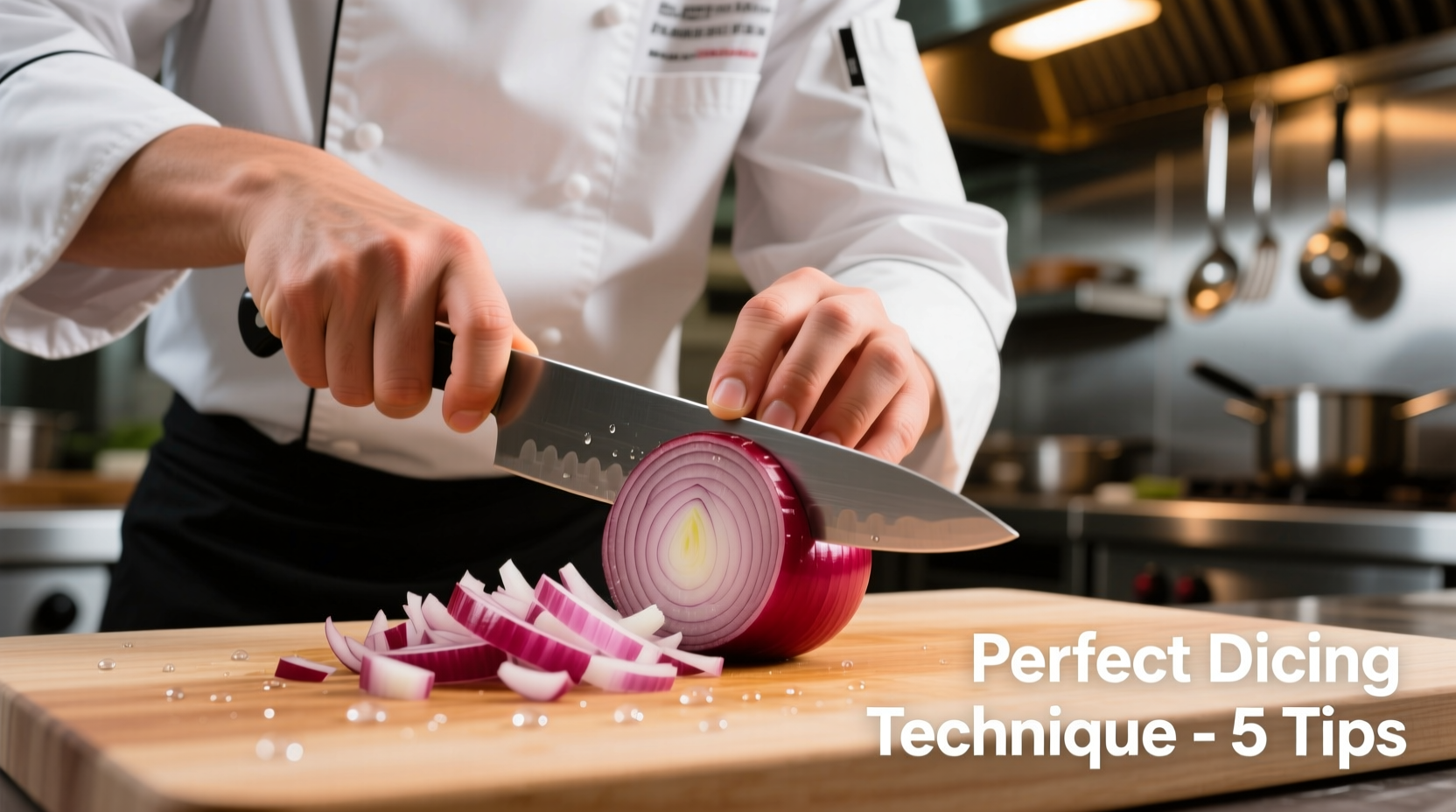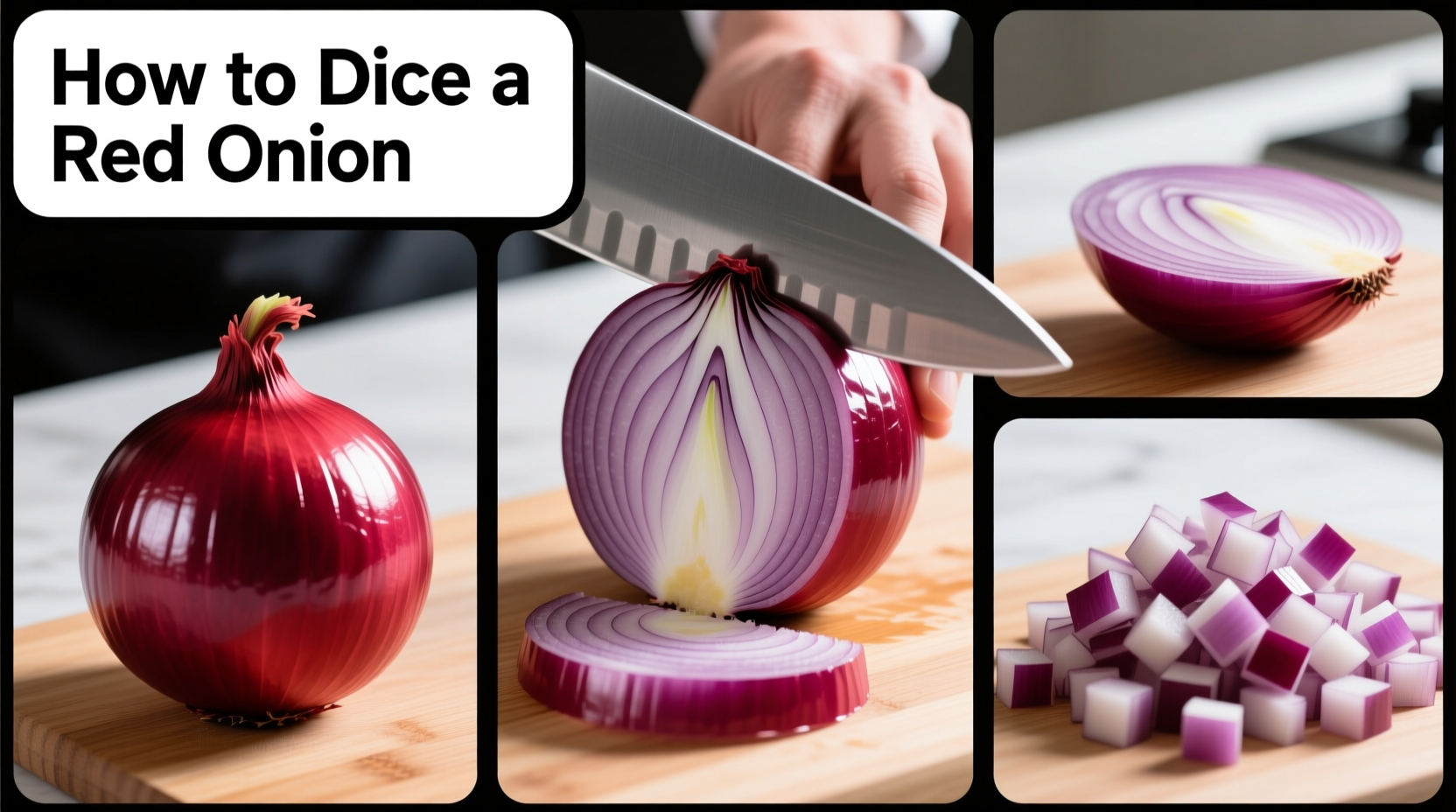Why Proper Red Onion Dicing Technique Matters
Getting your red onion dice right isn't just about appearance—it directly impacts flavor distribution, texture, and cooking performance in your dishes. Unlike white or yellow onions, red onions have a more delicate structure and vibrant color that requires specific handling to maintain their visual appeal and balanced flavor profile.
According to the U.S. Food and Drug Administration's food preparation guidelines, proper vegetable preparation techniques significantly affect nutrient retention and food safety. When you dice red onions correctly, you preserve more of their anthocyanins—the antioxidants responsible for their distinctive purple hue.
Essential Tools for Perfect Red Onion Dicing
Before you begin, gather these kitchen essentials:
- A sharp 7-8 inch chef's knife (dull knives cause more tearing and release more irritants)
- A stable cutting board (wood or composite works best for grip)
- A bowl of cold water (helps reduce eye irritation)
- Optional: mandoline slicer for ultra-consistent results
Professional chefs at the Culinary Institute of America emphasize that knife sharpness is critical—properly sharpened blades create cleaner cuts that minimize cell damage and reduce the release of syn-propanethial-S-oxide, the compound that makes you cry when cutting onions.
The Step-by-Step Red Onion Dicing Method
Follow these professional kitchen techniques for perfect red onion dice every time:
Step 1: Preparation
Place the onion on your cutting board and slice ¼ inch from both the root and stem ends. This creates stable, flat surfaces while preserving the root structure—which holds the onion layers together during cutting.
Step 2: Peeling
Remove the papery outer skin and first translucent layer. For red onions, take care not to remove too many layers as their color concentrates near the exterior. Soak the onion in cold water for 2-3 minutes to reduce irritation during peeling.
| Dicing Method | Best For | Texture Result | Time Required |
|---|---|---|---|
| Classic Dice | Salsas, salads, garnishes | Uniform ¼-inch cubes | 2-3 minutes |
| Julienne First | Ceviche, tartare | Fine, consistent strips | 3-4 minutes |
| Food Processor | Cooked dishes, soups | Inconsistent, mushy | 1 minute |
Step 3: Halving and Positioning
Place the onion flat side down and cut vertically through the root end to create two equal halves. Position one half flat-side down on your cutting board with the root end facing away from you.
Step 4: Vertical Cuts
Making sure to stop about ½ inch before the root end, make even vertical slices across the onion half. The spacing between cuts determines your dice size—¼ inch for small dice, ½ inch for medium. Keeping the root intact maintains structural integrity during the next steps.
Step 5: Horizontal Cuts
With the onion still positioned flat-side down, make 1-2 horizontal cuts parallel to the cutting board, again stopping short of the root. This creates the depth dimension for your dice.
Step 6: Final Dicing Motion
Starting from the stem end, slice perpendicular to your previous cuts toward the root. The onion should fall into perfectly uniform pieces as you cut. Discard the root end when finished.

Pro Tips for Professional Results
These chef-tested techniques will elevate your red onion dicing:
- Minimize tears: Chill onions for 30 minutes before cutting or cut under running water
- Consistent sizing: Use a ruler initially until you develop muscle memory for ¼-inch spacing
- Color preservation: Soak diced onions in ice water for 10 minutes to maintain vibrant color
- Safety first: Curl your fingertips under while cutting to protect them from the blade
When to Use Diced Red Onion
Understanding context boundaries is crucial for proper application of your diced red onions:
- Raw applications: Perfect for salsas, salads, and guacamole where their mild flavor and color shine
- Cooked dishes: Best added late in cooking to preserve color and prevent bitterness
- Substitutions: Not ideal for French onion soup or caramelized applications where yellow onions' sugar content performs better
- Storage: Keep in airtight container for up to 5 days; add a damp paper towel to maintain freshness
Food science research from the USDA National Institute of Food and Agriculture shows that red onions retain more quercetin—a powerful antioxidant—when diced properly and consumed raw compared to cooked applications. This makes them particularly valuable in fresh preparations where their nutritional benefits remain intact.
Troubleshooting Common Dicing Problems
Even experienced cooks encounter these issues:
- Mushy pieces: Caused by dull knives or over-handling—always use a sharp blade and work efficiently
- Inconsistent sizes: Results in uneven cooking—practice your vertical cut spacing for uniform results
- Excessive tearing: Chill onions first and maintain proper knife angle (45-degree angle reduces cell damage)
- Color bleeding: Rinse diced onions in cold water to stop pigment transfer in delicate dishes
Mastering the Art of Onion Preparation
Professional chefs have refined onion dicing techniques over centuries. Historical culinary texts show that medieval European cooks used much coarser chopping methods due to inferior knife technology. Modern precision dicing became possible only with the development of high-carbon steel blades in the 19th century.
Today's techniques represent the culmination of this evolution—combining safety, efficiency, and culinary science. By mastering this fundamental skill, you'll improve not just your onion preparation but your overall knife skills and kitchen confidence.











 浙公网安备
33010002000092号
浙公网安备
33010002000092号 浙B2-20120091-4
浙B2-20120091-4